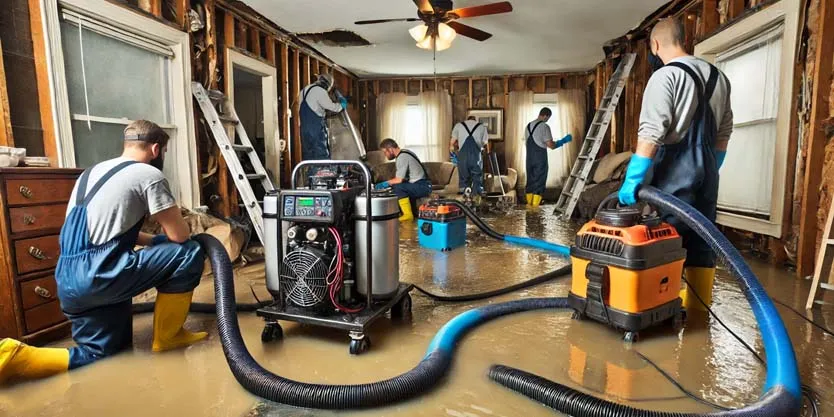How to clean up water damage effectively
When water invades your space, swift action is crucial. Discovering how to clean up water damage effectively not only preserves your property but also safeguards your health. This comprehensive guide dives into the must-know steps, ensuring you’re armed with the expertise to tackle water woes head-on.
Firstly, assess the damage. Identifying the source and extent of water intrusion is key—be it a burst pipe, flooded basement, or a leaky roof. Immediate containment prevents further havoc, setting the stage for successful restoration. Remember, safety comes first; always shut off electrical power to the affected area.
Now, gear up for cleanup. Start by removing standing water, utilizing pumps or wet-dry vacuums if necessary. Salvageable items should be dried and disinfected; however, waterlogged materials might require discarding. Dehumidifiers and fans are your allies in drying out the premises, followed by a thorough disinfection to eliminate potential mold and bacteria. Consistency and a meticulous approach are your pillars of recovery in your water damage crusade.
Steps to Take Immediately After Water Damage Occurrence
When faced with water damage in your home, acting swiftly to mitigate further damage is crucial. Immediate action can help minimize long-term issues and restoration costs. Here are key actions you should take:
- Ensure safety: Before you handle any water damage, make sure it’s safe to enter your home. Look out for electrical hazards and structural damage.
- Stop the source of water: If possible, stop the water at its source. For leaks, shut off the main water valve.
- Remove excess water: Start mopping and blotting to remove as much water as you can. Use a wet-dry vacuum if available.
- Circulate air: Open windows and use fans to circulate air and aid the drying process.
- Document the damage: Take photos or videos to document the damage for insurance purposes.
Effective Drying and Dehumidifying Strategies
Thorough drying is crucial to prevent mold growth and structural damage. Here’s how you can effectively dry out your space:
- Use dehumidifiers: Industrial-strength dehumidifiers can help pull moisture from the air and accelerate drying.
- Enable better airflow: Use fans to boost air circulation, and remember to move them around the affected area every few hours.
- Focus on hidden areas: Ensure you dry out hidden spaces like under carpets, behind walls, and in crawl spaces.
Identifying and Eliminating Mold and Mildew
Mold and mildew can present serious health risks. Removing them effectively entails:
- Inspect for mold: Carefully check for signs of mold, especially in damp and dark places.
- Clean with anti-mold solutions: Utilize mold-killing solutions or a mixture of bleach and water to clean non-porous surfaces.
For detailed assistance on detecting hidden leaks and preventing long-term damages, consider browsing murale lekdetectie diensten, which provides a non-invasive approach to finding leaks without destruction to your property.
Salvaging and Restoring Personal Property
Water damage can ruin valuables. Here are tips for salvaging personal property:
- Sort items: Determine what’s salvageable. Porous items like mattresses may need to be discarded.
- Clean and disinfect: Non-porous items can often be cleaned and disinfected. Gentle air-drying or use of a fan is recommended.
If you’re dealing with extensive water-related damage to your wall structures and need professional help, klik hier voor muur lekkage expertise from Ultrices Lekdetectie, with no cure no pay policy, certified experts and a detailed report within three working days.
Collaborating with Insurance and Understanding Your Coverage
Navigating insurance claims can be complex. Ensure you understand your policy coverages and work closely with your insurance company. Keep comprehensive records of all communications and maintain receipts for out-of-pocket expenses and restoration services.
Professional Water Damage Cleanup Services
Professional water damage restoration services play a vital role in returning your home to a safe and livable condition. Ultrices Lekdetectie offers expert services across the Netherlands, complete with VCA certification and no cure no pay assurance. If you need assistance, our expertise is just a click away.
Taking Preventative Measures to Avoid Future Water Damage
Lastly, take proactive steps to prevent future water damage. Regular maintenance of plumbing systems, proper landscaping to direct water away from the foundation, and installing water detection systems can help avert potential disasters.Remember, effective water damage cleanup is paramount to protecting your home and health. By following these strategies and enlisting professional help when necessary, you can restore your living space efficiently and effectively.
FAQ: How to Clean Up Water Damage Effectively
1. What’s the first thing I should do when I notice water damage?
When you first spot water damage, immediately shut off your main water supply if the damage involves a burst pipe or leak. Then, unplug electronics and remove them along with other movable items away from the affected area to prevent further damage. Your priority is safety and halting the spread of moisture.
2. How can I effectively dry out water-damaged areas?
Start with opening windows and using fans to circulate air. If the damage isn’t extensive, household fans can sometimes do the job. However, for larger areas or more severe damage, consider using a high-volume fan or dehumidifier. Check the space regularly and move the equipment around to ensure thorough drying.
3. Should I attempt to clean and repair water damage by myself?
If the damage is light, like a small leak with no significant structural issues, you can probably manage on your own. For anything more serious—think flooding or water that’s been sitting—you’re better off calling in the professionals to prevent mold, rot, and other long-term issues.
4. Can I prevent mold after water damage, and if so, how?
To stave off mold growth, be quick and thorough with drying efforts—mold can start developing within 24-48 hours. After drying, clean the affected surfaces with a mold-prevention solution or diluted bleach. Keep the area dry with continued ventilation and monitor for any signs of mold taking hold.
5. What’s essential to know about insurance coverage for water damage?
Understand your insurance policy; it may cover water damage caused by internal sources like burst pipes but might exclude flood damage. Promptly document the damage with photos and contact your insurance provider as soon as possible to report a claim and get advice on your coverage and the claims process.











Post Comment